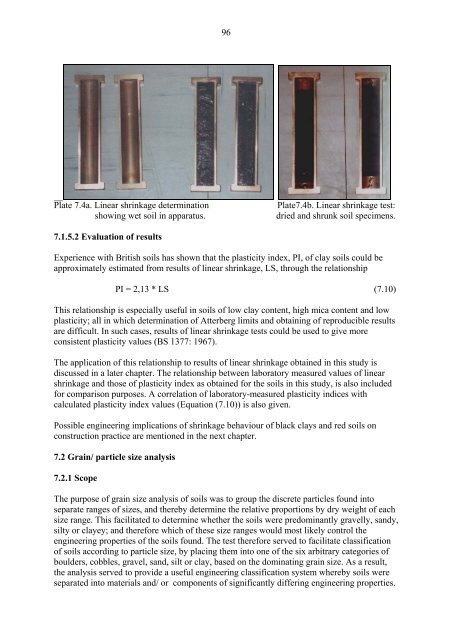an engineering geological characterisation of tropical clays - GBV
an engineering geological characterisation of tropical clays - GBV
an engineering geological characterisation of tropical clays - GBV
Create successful ePaper yourself
Turn your PDF publications into a flip-book with our unique Google optimized e-Paper software.
96<br />
Plate 7.4a. Linear shrinkage determination<br />
showing wet soil in apparatus.<br />
Plate7.4b. Linear shrinkage test:<br />
dried <strong>an</strong>d shrunk soil specimens.<br />
7.1.5.2 Evaluation <strong>of</strong> results<br />
Experience with British soils has shown that the plasticity index, PI, <strong>of</strong> clay soils could be<br />
approximately estimated from results <strong>of</strong> linear shrinkage, LS, through the relationship<br />
PI = 2,13 * LS (7.10)<br />
This relationship is especially useful in soils <strong>of</strong> low clay content, high mica content <strong>an</strong>d low<br />
plasticity; all in which determination <strong>of</strong> Atterberg limits <strong>an</strong>d obtaining <strong>of</strong> reproducible results<br />
are difficult. In such cases, results <strong>of</strong> linear shrinkage tests could be used to give more<br />
consistent plasticity values (BS 1377: 1967).<br />
The application <strong>of</strong> this relationship to results <strong>of</strong> linear shrinkage obtained in this study is<br />
discussed in a later chapter. The relationship between laboratory measured values <strong>of</strong> linear<br />
shrinkage <strong>an</strong>d those <strong>of</strong> plasticity index as obtained for the soils in this study, is also included<br />
for comparison purposes. A correlation <strong>of</strong> laboratory-measured plasticity indices with<br />
calculated plasticity index values (Equation (7.10)) is also given.<br />
Possible <strong>engineering</strong> implications <strong>of</strong> shrinkage behaviour <strong>of</strong> black <strong>clays</strong> <strong>an</strong>d red soils on<br />
construction practice are mentioned in the next chapter.<br />
7.2 Grain/ particle size <strong>an</strong>alysis<br />
7.2.1 Scope<br />
The purpose <strong>of</strong> grain size <strong>an</strong>alysis <strong>of</strong> soils was to group the discrete particles found into<br />
separate r<strong>an</strong>ges <strong>of</strong> sizes, <strong>an</strong>d thereby determine the relative proportions by dry weight <strong>of</strong> each<br />
size r<strong>an</strong>ge. This facilitated to determine whether the soils were predomin<strong>an</strong>tly gravelly, s<strong>an</strong>dy,<br />
silty or clayey; <strong>an</strong>d therefore which <strong>of</strong> these size r<strong>an</strong>ges would most likely control the<br />
<strong>engineering</strong> properties <strong>of</strong> the soils found. The test therefore served to facilitate classification<br />
<strong>of</strong> soils according to particle size, by placing them into one <strong>of</strong> the six arbitrary categories <strong>of</strong><br />
boulders, cobbles, gravel, s<strong>an</strong>d, silt or clay, based on the dominating grain size. As a result,<br />
the <strong>an</strong>alysis served to provide a useful <strong>engineering</strong> classification system whereby soils were<br />
separated into materials <strong>an</strong>d/ or components <strong>of</strong> signific<strong>an</strong>tly differing <strong>engineering</strong> properties.
















